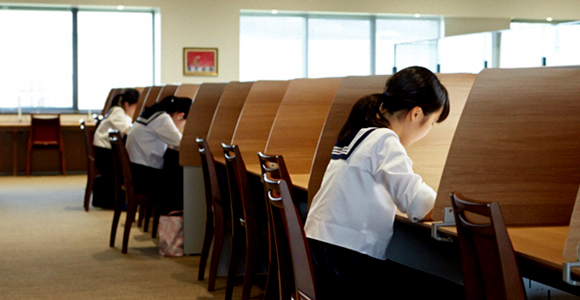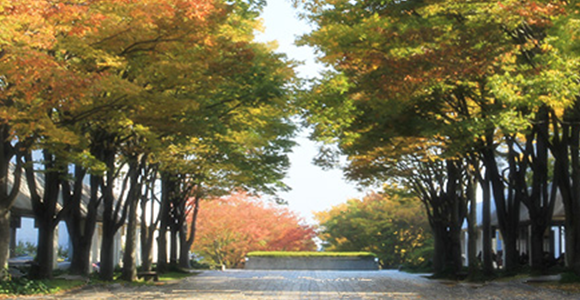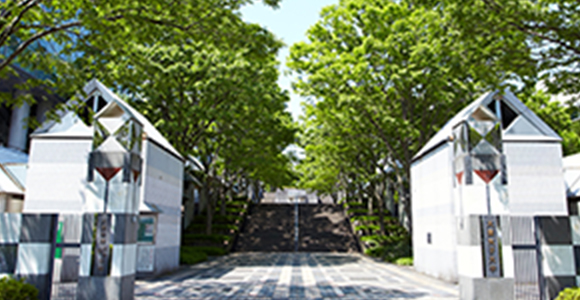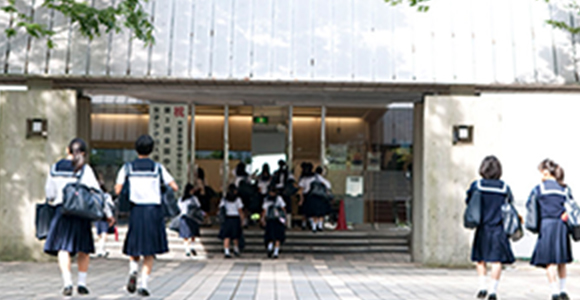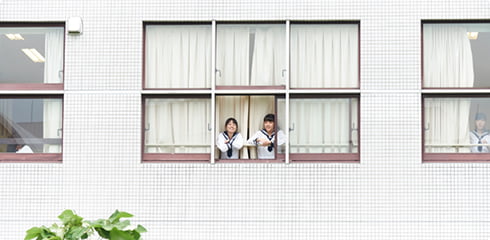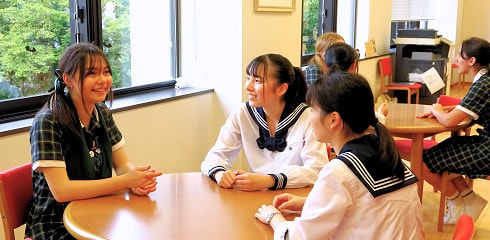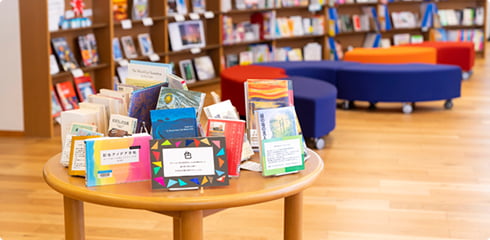【英語・国際】ターム留学中間報告「オーストラリア(アデレード)コース」(高1 Hさん)
更新日時:2025年3月14日

【英語・国際】ターム留学中間報告「オーストラリア(アデレード)コース」(高1 Hさん)
ごきげんよう!私は今オーストラリアのアデレードに留学しています。オーストラリアに来て早くも4週間が経ちました。最初は「あと二か月もあるのか」と長く感じていましたが、実際に生活を始めると、毎日がとても充実していて、あっという間に過ぎていきます。
現在、オーストラリアは夏真っ盛りで、気温が 40 度を超える日もあります。アデレードは自然が豊かで、庭先に野生のオウムがやって来ることもあり、驚きと発見の連続です。ようやく新しい環境にも慣れ、今ではとても楽しい毎日を送っています。
これから、私のホストファミリーとの生活や学校での経験、そして日本とオーストラリアの違いについてお話ししたいと思います。
 Hello! I’m currently studying abroad in Adelaide, Australia. It’s already been four weeks since I arrived. At first, I felt two more months would be a long time, but now that I’ve started my life here, every day feels so fulfilling, and time is flying by.
Right now, it’s the middle of summer in Australia, and some days the temperature goes over 40 degrees. Adelaide parrots even come to people’s yards. Every day is full of surprises and new discoveries. I’ve finally gotten used to my new background, and now I’m really enjoying my time.
From now on, I’d like to share my experiences about my host family, at my school, and the differences between Japan and Australia.
Hello! I’m currently studying abroad in Adelaide, Australia. It’s already been four weeks since I arrived. At first, I felt two more months would be a long time, but now that I’ve started my life here, every day feels so fulfilling, and time is flying by.
Right now, it’s the middle of summer in Australia, and some days the temperature goes over 40 degrees. Adelaide parrots even come to people’s yards. Every day is full of surprises and new discoveries. I’ve finally gotten used to my new background, and now I’m really enjoying my time.
From now on, I’d like to share my experiences about my host family, at my school, and the differences between Japan and Australia.
〔ホームステイ〕
最初のホストファミリーはホストマザー、大学生の息子、中国人留学生、ベトナム人の留学生と一緒に暮らしていました。その家では、それぞれが自分のペースで生活しており、日本とは異なる文化をたくさん経験しました。例えば、洗濯は週1回、シャワーは5分以内、家の鍵を閉めずに過ごすといった習慣には驚きましたが、その分、多くのことを学ぶことができました。 その家で1週間過ごした後、新しいホストファミリーの家に移ることになりました。今のホストファミリーは、中国人ホストマザー、16 歳のベトナム人留学生が 2 人、23 歳の日本人留学生、そして私の 5 人暮らしです。最初は不安もありましたが、「何でも聞いてね」と温かく迎え入れてくれたおかげで、すごく安心できました。 ホストマザーは料理が得意で、これまでに多くの日本人留学生を受け入れた経験があるため、お米を炊いたり、お寿司や牛丼を作ってくれたりと、私のことをとても気にかけてくれています。初めての週末には、家から車で 20 分ほどのビーチへ行き、海を眺めながらローストチキンを一緒に食べました。先日は味噌を買ってきてくれ、「今度一緒に味噌汁を作ろうね」と計画しています。
Homestay
My first host family included my host mother, her son of a college student, Chinese international student, Vietnamese international student. In that house, everyone lived at their own pace, and I experienced a lot of cultural differences from Japan. For example, I was surprised by things like only doing laundry once a week, taking showers in under five minutes, and not locking the doors. But at that time, I learned so much from those experiences. After spending a week at that house, I moved to a new host family house. My current host family consists of my Chinese host mother, two 16-year-old Vietnamese international students, 23-year-old a Japanese international student, and myself; five of us in total. At first, I was a bit nervous, but she welcomed me warmly, saying, “Feel free to ask anything!” That made me feel safe. My host mother is good at cooking, and since she has hosted many Japanese international students before, she is very considerate of me. She even cooks rice, sushi, and Gyudon for me. On my first weekend, we went to the beach for about 20 minutes by car, and now we are planning to make miso soup together.
〔学校〕
私は現在、南オーストラリア州で唯一の公立女子高である Mitcham Girls High School にYear10(高校一年生)として通っています。授業は月曜日から金曜日まであり、1 コマは 1 時間、一日 6 限のスケジュールですが、水曜日だけは5限で終わります。学校へはバスで40分、その後徒歩5分ほどかけて通っています。
学校には中国、韓国、ベトナムなどさまざまな国籍の生徒が在籍しており、国際豊かな環境です。私は数学、生物、歴史、体育、フード、英語、デザインテクノロジーの授業を受けています。
フードの授業ではクラスメイトとグループを組み、チョコレートクッキーやカップケーキ、チキンライスなどさまざまな料理を作ります。デザインテクノロジーは本格的な図工のような授業で、特殊な機械を使って木を切ったり、ハンマーで削ったりしながら作品を制作します。
英語での授業は、最初はほとんど理解できず苦労しましたが、授業後先生に質問しに行くなど工夫を重ねることで、以前よりも聞き取れるようになってきました。少しずつ成長を実感できるのが嬉しいです。

School
Right now, I’m studying at Mitcham Girls’ High School, the only public all girls school in South Australia, as Year 10 student (first year high school in Japan). Classes run from Monday to Friday, with each period of one hour. There are up to six periods a day, except on Wednesday, when school finishes after the fifth period. It takes me about 40 minutes by bus and after those 5 minutes by walk to get to school. The school has students from many different backgrounds, including China, Korea, Vietnam, making it a very international background. I’m taking classes in math, biology, history, PE, food, English, and design technology. In food class, I work in groups making many kinds of dishes, like chocolate cookies, cupcakes,and chicken rice. Design Technology is like an advanced version of arts and crafts. I use special machines to cut wood and shape it with hammers to create different projects. At first, I couldn’t understand anything in my English classes, which was really challenging. But when I ask my teachers questions after class and find ways to improve, I’ve started to understand more and more. It makes me happy to feel myself gradually improving.
〔日本とオーストラリアの違い〕
① バスの乗り方 日本のバスには電光掲示板があり、次の停留所が表示されますが、オーストラリアのバスにはそれがないものが多く、外の景色を見ながら自分の降りるバス停を確認し、タイミングを見計らってボタンを押さなければなりません。また、オーストラリアではバス停に立っているだけではバスは止まってくれません。バスが近づいてきたら手を挙げて運転手に乗る意思を伝える必要があります。さらに、バスは遅延が当たり前、逆に予定時刻より早く出発することもあるため、Google マップなどを活用しながらバスの位置を自分でしっかり確認しなければなりません。最初はとても戸惑いましたが、今ではスムーズに乗れるようになってきました。 ② 学校の授業 オーストラリアの学校では、生徒一人ひとりが自分の意見を持ち、授業中も積極的に発言します。日本のような「先生が教えて生徒が聞く」スタイルではなく、対話型の授業が一般的です。また、紙のプリントはほとんど使わず、パソコンのデータを活用して授業が進められるのも大きな違いです。 中学二年生からずっと目指していた留学が実現し、今、日本ではできない貴重な体験をたくさんしています。異国の地での生活は大変なこともありますが、その分、自分で考え行動する力が身につき、とても充実した毎日を送っています。この1か月で最も成長したと感じるのは、積極性と自力でやる力です。自分から動かなければ何も始まらない環境の中で、少しずつ主体的に行動できるようになりました。残りの1か月、悔いのないように過ごし、支えてくれている周りの人への感謝を忘れずに、英語をもっと話せるようになって帰国したいと思いま す。
Differences Between Japan and Australia
① How to ride the bus
In Japan, buses usually have an electronic display showing the next stop. However, many buses in Australia don’t have this, so I must watch the outside and press the button at the right time to get off at my stop. Also, in Australia, just standing at the bus stop isn’t enough the bus won’t stop, so I should raise my hand to signal the driver that I want to get on. Also, buses are often delayed, and sometimes even leave earlier. That’s why you need to keep track of the bus location using Google Maps or other apps. At first, I was really confused, but now I’ve gotten used to it and I can ride the bus smoothly.
② Classes at school
In Australian schools, every student has their own opinions and actively speaks up during class. Instead of the Japanese style, where the teacher talks and students listen, most lessons are more interactive, and discussion-based. Another big difference is that students don’t use handouts. Instead, classes rely on digital materials, with students using their laptops for most of their work.
Studying abroad has been a dream since I was in my second year of junior high school, and now it has finally come true. I have been experiencing so many things that I wouldn’t be able to do in Japan. Living abroad isn’t always easy, but it has helped me become more independent and take the ability to think and act on my own. Every day feels fulfilling. Over the past month, I feel like I’ve grown the most in terms of being proactive and doing things on my own in the background where nothing happens unless I take the lead. With one month left, I want to make the most of my time here, and I appreciate the people who have supported me, before I go back to Japan.



